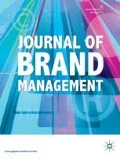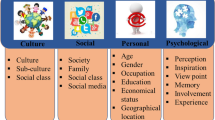Abstract
Built on reference dependence, this study investigated how the framing of cost information affects perceived gains and losses, and tested the mediating roles of gain and loss perceptions in the relationship between cost information and price fairness, which in turn, increase buying intentions toward the apparel brand. A between-subjects study was designed to test the hypotheses and our sample consisted of a total of 804 U.S. participants who responded to our online survey. The results showed that disclosing the true cost and markup of a product along with its retail price was a more effective way to increase the perceived gain of buying and also the loss of not buying the product than when only the retail price was presented. Differently framed cost information triggered price fairness and buying intentions only through gain perceptions, but not through loss perceptions. The results of this research demonstrate the power of cost transparency using reference points for effective apparel brand strategies. Theoretical and practical implications were also discussed.


Similar content being viewed by others
References
Armstrong, J.S., and T.S. Overton. 1977. Estimating nonresponse bias in mail surveys. Journal of Marketing Research 14(3): 396–402.
Baker, J., A. Parasuraman, D. Grewal, and G.B. Voss. 2002. The influence of multiple store environment cues on perceived merchandise value and patronage intentions. Journal of Marketing 66(2): 120–141.
Baron, R.M., and D.A. Kenny. 1986. The moderator–mediator variable distinction in social psychological research: Conceptual, strategic, and statistical considerations. Journal of Personality and Social Psychology 51(6): 1173–1182.
Biswas, A., and E.A. Blair. 1991. Contextual effects of reference prices in retail advertisements. Journal of Marketing 55(3): 1–12.
Blackston, M. 1992. A brand with an attitude: A suitable case for the treatment. Journal of the Market Research Society 34(3): 231–241.
Bolton, R.N., and K.N. Lemon. 1999. A dynamic model of customers’ usage of services: Usage as an antecedent and consequence of satisfaction. Journal of Marketing Research 36(2): 171–186.
Bolton, L.E., L. Warlop, and J.W. Alba. 2003. Consumer perceptions of price (un) fairness. Journal of Consumer Research 29(4): 474–491.
Briesch, R.A., L. Krishnamurthi, T. Mazumdar, and S.P. Raj. 1997. A comparative analysis of reference price models. Journal of Consumer Research 24(2): 202–214.
Byun, S.E., and B. Sternquist. 2012. Here today, gone tomorrow: Consumer reactions to perceived limited availability. Journal of Marketing Theory and Practice 20(2): 223–234.
Campbell, M.C. 1999. Perceptions of price unfairness: Antecedents and consequences. Journal of Marketing Research 36(2): 187–199.
Campbell, M.C. 2007. Says who?! How the source of price information and affect influence perceived price (un)fairness. Journal of Marketing Research 44(2): 261–271.
Chandrashekaran, R. 2012. Consumers’ utilization of reference prices: The moderating role of involvement. Journal of Product & Brand Management 21(1): 53–60.
Chang, T.Z., and A.R. Wildt. 1994. Price, product information, and purchase intention: An empirical study. Journal of the Academy of Marketing Science 22(1): 16–27.
Chen, Z., and A.J. Dubinsky. 2003. A conceptual model of perceived customer value in e-commerce: A preliminary investigation. Psychology & Marketing 20(4): 323–347.
Cooke, A.D., T. Meyvis, and A. Schwartz. 2001. Avoiding future regret in purchase-timing decisions. Journal of Consumer Research 27(4): 447–459.
Crosno, J.L., and A.P. Cui. 2018. Something old, something new: The role of partitioned pricing in consumers’ preference for new versus used products. Journal of Consumer Marketing 35(4): 353–365.
Desarbo, W.S., K. Jedidi, and I. Sinha. 2001. Customer value analysis in a heterogeneous market. Strategic Management Journal 22(9): 845–857.
Dholakia, U.M., and I. Simonson. 2005. The effect of explicit reference points on consumer choice and online bidding behavior. Marketing Science 24(2): 206–217.
Ferguson, J.L., and P.S. Ellen. 2013. Transparency in pricing and its effect on perceived price fairness. Journal of Product & Brand Management 22(5/6): 404–412.
Flax, J., G. Bick, and R. Abratt. 2016. The perceptions of supplier–buyer relations and its affect on the corporate brand. Journal of Brand Management 23(1): 22–37.
Genesove, D., and C. Mayer. 2001. Loss aversion and seller behavior: Evidence from the housing market. The Quarterly Journal of Economics 116(4): 1233–1260.
Grewal, D., K.B. Monroe, and R. Krishnan. 1998. The effects of price-comparison advertising on buyers’ perceptions of acquisition value, transaction value, and behavioral intentions. Journal of Marketing 62(2): 46–59.
Gupta, S., and H.W. Kim. 2010. Value-driven Internet shopping: The mental accounting theory Perspective. Psychology & Marketing 27(1): 13–35.
Hair, J.F., W.C. Black, B.J. Babin, and R.E. Anderson. 2010. Multivariate data analysis. 7th ed. Upper Saddle River, NJ: Prentice Hall.
Han, S., S. Gupta, and D.R. Lehmann. 2001. Consumer price sensitivity and price thresholds. Journal of Retailing 77(4): 435–456.
Hardesty, D.M., and T.A. Suter. 2005. E-tail and retail reference price effects. Journal of Product & Brand Management 14(2): 129–136.
Hardie, B.G., E.J. Johnson, and P.S. Fader. 1993. Modeling loss aversion and reference dependence effects on brand choice. Marketing Science 12(4): 378–394.
Haws, K.L., and W.O. Bearden. 2006. Dynamic pricing and consumer fairness perceptions. Journal of Consumer Research 33(3): 304–311.
Hayes, A.F., and K.J. Preacher. 2014. Statistical mediating analysis with a multicategorical independent variable. British Journal of Mathematical and Statistical Psychology 67(3): 451–470.
Helson, H. 1964. Adaptation-level theory: An experimental and systematic approach to behavior. New York, NY: Harper and Row.
Holmbeck, G.N. 1997. Toward terminological, conceptual, and statistical clarity in the study of mediators and moderators: Examples from the child-clinical and pediatric psychology literatures. Journal of Consulting and Clinical Psychology 65(4): 599–610.
Huang, J.H., C.T. Chang, and C.Y.H. Chen. 2005. Perceived fairness of pricing on the internet. Journal of Economic Psychology 26(3): 343–361.
Jin, B., H.J. Chang, D.R. Matthews, and M. Gupta. 2012. Fast fashion business model: What, why and how?”. In Fashion supply chain management: Industry and business analysis, ed. T.-M. Choi, 193–211. Hershey, PA: IGL Global.
Kahneman, D., J.L. Knetsch, and R. Thaler. 1986. Fairness as a constraint on profit seeking: Entitlements in the market. The American Economic Review 76(4): 728–741.
Kahneman, D., and A. Tversky. 1979. Prospect theory: An analysis of decision under risk. Econometrica 47(2): 363–391.
Kalyanaram, G., and J.D. Little. 1994. An empirical analysis of latitude of price acceptance in consumer package goods. Journal of Consumer Research 21(3): 408–418.
Kalyanaram, G., and R.S. Winer. 1995. Empirical generalizations from reference price research. Marketing Science 14(3): G161–G169.
Kang, J., and G. Hustvedt. 2014. Building trust between consumers and corporations: The role of consumer perceptions of transparency and social responsibility. Journal of Business Ethics 125(2): 253–265.
Kenning, P., H. Evanschitzky, V. Vogel, and D. Ahlert. 2007. Consumer price knowledge in the market for apparel. International Journal of Retail & Distribution Management 35(2): 97–119.
Krishnamurthi, L., T. Mazumdar, and S.P. Raj. 1992. Asymmetric response to price in consumer brand choice and purchase quantity decisions. Journal of Consumer Research 19(3): 387–400.
Kuah, A.T.H., and V. Weerakkody. 2015. Is cost transparency necessarily good for consumers? European Journal of Marketing 49(11/12): 1980–1986.
Kunz, G.I., E. Karpova, and M.B. Garner. 2016. Going global: The textile and apparel industry. 3rd ed. New York, NY: Bloomsbury.
Lichtenstein, D.R., S. Burton, and E.J. Karson. 1991. The effect of semantic cues on consumer perceptions of reference price ads. Journal of Consumer Research 18(3): 380–391.
Lichtenstein, D.R., N.M. Ridgway, and R.G. Netemeyer. 1993. Price perceptions and consumer shopping behavior: A field study. Journal of Marketing Research 30(2): 234–245.
Lowe, B. 2015. “Should consumers request cost transparency?” cost transparency in consumer markets. European Journal of Marketing 49(11–12): 1992–1998.
Luk, S.T., and L.S. Yip. 2008. The moderator effect of monetary sales promotion on the relationship between brand trust and purchase behaviour. Journal of Brand Management 15(6): 452–464.
Ma, Y.J., H.H. Lee, and K. Goerlitz. 2016. Transparency of global apparel supply chains: Quantitative analysis of corporate disclosures. Corporate Social Responsibility and Environmental Management 23(5): 308–318.
Martin, W.C., N. Ponder, and J.E. Lueg. 2009. Price fairness perceptions and customer loyalty in a retail context. Journal of Business Research 62(6): 588–593.
Maxwell, S. 2002. Rule-based price fairness and its effect on willingness to purchase. Journal of Economic Psychology 23(2): 191–212.
Mazumdar, T., and P. Papatla. 2000. An investigation of reference price segments. Journal of Marketing Research 37(2): 246–258.
Mohan, B., R.W. Buell, and L.L. John. 2015. Lifting the veil: The benefits of cost transparency. Harvard Business Review. https://papers.ssrn.com/sol3/papers.cfm?abstract_id=2498174. Accessed 22 May 2017.
Novemsky, N., and D. Kahneman. 2005. The boundaries of loss aversion. Journal of Marketing Research 42(2): 119–128.
Pearson, B. 2017. Transparent pricing: Shedding light on the real value of a shirt, and brand. Forbes. Retrieved April 3, 2018, from https://www.forbes.com/sites/bryanpearson/2017/07/25/transparent-pricing-shedding-light-on-the-real-value-of-a-shirt-and-brand/#701d32866acc.
Piron, R., and L. Fernandez. 1995. Are fairness constraints on profit-seeking important? Journal of Economic Psychology 16(1): 73–96.
Popp, B., and H. Woratschek. 2017. Consumer-brand identification revisited: An integrative framework of brand identification, customer satisfaction, and price image and their role for brand loyalty and word of mouth. Journal of Brand Management 24(3): 250–270.
Preacher, K., D. Rucker, and A. Hayes. 2007. Assessing moderated mediation hypotheses: Theory, methods and prescriptions. Multivariate Behavioral Research 42(1): 185–227.
Putler, D.S. 1992. Incorporating reference price effects into a theory of consumer choice. Marketing Science 11(3): 287–309.
Ryder, I. 2004. Anthropology and the brand. Journal of Brand Management 11(5): 346–356.
Şen, A. 2008. The US fashion industry: A supply chain review. International Journal of Production Economics 114(2): 571–593.
Simintiras, A.C., Y.K. Dwivedi, G. Kaushik, and N.P. Rana. 2015. Should consumers request cost transparency? European Journal of Marketing 49(11/12): 1961–1979.
Singh, N. 2015. What’s behind the price tag: Understanding cost transparency? European Journal of Marketing 49(11/12): 1987–1991.
Sinha, I. 2000. Cost transparency: The net’s real threat to prices and brands. Harvard Business Review 78(2): 43–43.
Sweeney, J.C., G.N. Soutar, and L.W. Johnson. 1999. The role of perceived risk in the quality-value relationship: A study in a retail environment. Journal of Retailing 75(1): 77–105.
Thaler, R. 1985. Mental accounting and consumer choice. Marketing Science 4(3): 199–214.
Tversky, A., and D. Kahneman. 1981. The framing of decisions and the psychology of choice. Science 211(4481): 453–458.
Vaidyanathan, R., and P. Aggarwal. 2003. Who is the fairest of them all? An attributional approach to price fairness perceptions. Journal of Business Research 56(6): 453–463.
White, K., R. MacDonnell, and D.W. Dahl. 2011. It’s the mind-set that matters: The role of construal level and message framing in influencing consumer efficacy and conservation behaviors. Journal of Marketing Research 48(3): 472–485.
Wilkie, D.C.H., L.W. Johnson, and L. White. 2015. The line extension dilemma: Greater difference or similarity to existing products? Journal of Brand Management 22(6): 534–550.
Winer, R. 1988. Behavioral perspectives on pricing: Buyers’ subjective perceptions of price revisited. In Issues in pricing: Theory and research, ed. T.M. Divinney, 35–57. Lexington, MA: Lexington Books.
Xia, L., K.B. Monroe, and J.L. Cox. 2004. The price is unfair! A conceptual framework of price fairness perceptions. Journal of Marketing 68(4): 1–15.
Zhu, Y., and H.A. Chen. 2017. A tale of two brands: The joint effect of manufacturer and retailer brands on consumers’ product evaluation. Journal of Brand Management 24(3): 284–306.
Acknowledgements
This work was supported by a grant from Kyung Hee University in 2018 (KHU-20180936).
Author information
Authors and Affiliations
Corresponding author
Ethics declarations
Conflict of interest
On behalf of all authors, the corresponding author states that there is no conflict of interest.
Additional information
Publisher's Note
Springer Nature remains neutral with regard to jurisdictional claims in published maps and institutional affiliations.
Appendix 1
Appendix 1
Stimuli examples ($120 of the product).

Rights and permissions
About this article
Cite this article
Jung, S., Cho, H.J. & Jin, B.E. Does effective cost transparency increase price fairness? An analysis of apparel brand strategies. J Brand Manag 27, 495–507 (2020). https://doi.org/10.1057/s41262-020-00191-w
Revised:
Published:
Issue Date:
DOI: https://doi.org/10.1057/s41262-020-00191-w




